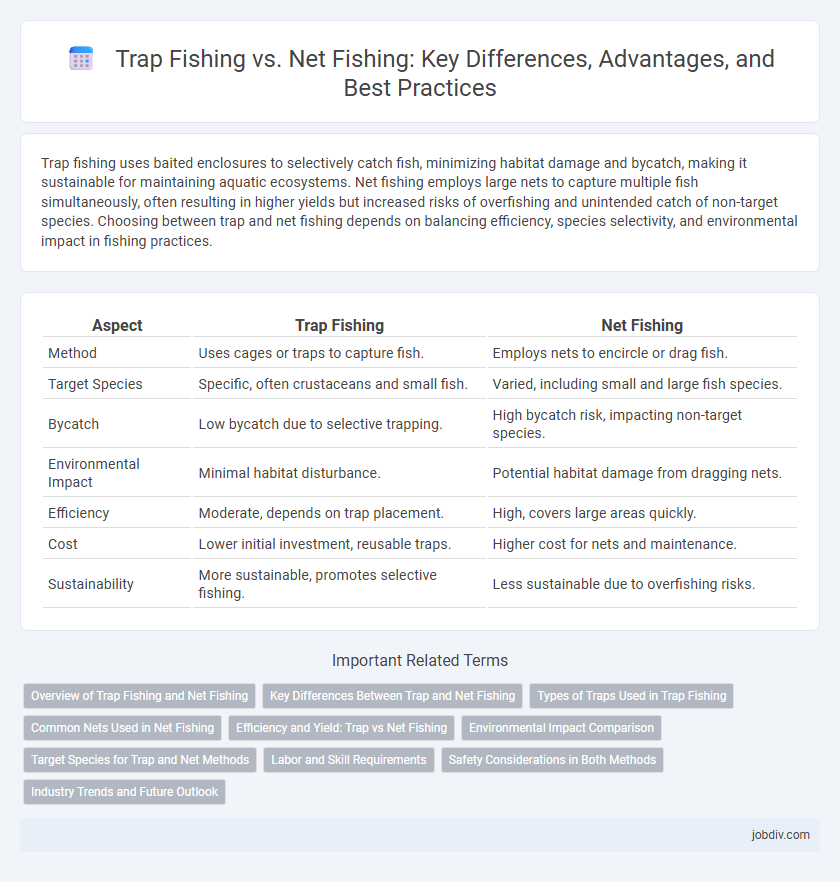Trap fishing uses baited enclosures to selectively catch fish, minimizing habitat damage and bycatch, making it sustainable for maintaining aquatic ecosystems. Net fishing employs large nets to capture multiple fish simultaneously, often resulting in higher yields but increased risks of overfishing and unintended catch of non-target species. Choosing between trap and net fishing depends on balancing efficiency, species selectivity, and environmental impact in fishing practices.
Table of Comparison
| Aspect | Trap Fishing | Net Fishing |
|---|---|---|
| Method | Uses cages or traps to capture fish. | Employs nets to encircle or drag fish. |
| Target Species | Specific, often crustaceans and small fish. | Varied, including small and large fish species. |
| Bycatch | Low bycatch due to selective trapping. | High bycatch risk, impacting non-target species. |
| Environmental Impact | Minimal habitat disturbance. | Potential habitat damage from dragging nets. |
| Efficiency | Moderate, depends on trap placement. | High, covers large areas quickly. |
| Cost | Lower initial investment, reusable traps. | Higher cost for nets and maintenance. |
| Sustainability | More sustainable, promotes selective fishing. | Less sustainable due to overfishing risks. |
Overview of Trap Fishing and Net Fishing
Trap fishing involves using baited or unbaited traps to capture fish by enticing them into confined enclosures, often designed to allow escape only in one direction, resulting in selective and sustainable catches. Net fishing employs various types of nets such as gillnets, seine nets, and trawl nets to encircle or entangle fish, enabling efficient capture of large quantities but raising concerns about bycatch and habitat impact. Both methods vary in environmental footprint and target specificity, influencing their suitability for different fisheries and conservation goals.
Key Differences Between Trap and Net Fishing
Trap fishing involves using baited containers or enclosures to capture specific species, promoting selective harvesting and reducing bycatch. Net fishing employs large mesh devices that encircle or intercept fish, allowing for mass capture but often impacting non-target species and habitats. The key differences lie in their operational methods, environmental impact, and species selectivity.
Types of Traps Used in Trap Fishing
Trap fishing employs various types of traps such as pot traps, fyke nets, and box traps designed to capture species like crabs, lobsters, and fish by allowing entry but preventing escape. Pot traps are commonly baited and placed on the seafloor to target bottom-dwelling species, while fyke nets function as funnel-shaped traps effective in shallow waters and rivers. Box traps are versatile and used in both freshwater and marine environments, offering selective fishing that minimizes bycatch compared to traditional net fishing methods.
Common Nets Used in Net Fishing
Common nets used in net fishing include gillnets, trawl nets, and seine nets, each designed for specific fish species and habitats. Gillnets function by entangling fish by their gills, trawl nets capture fish by dragging through the water or along the bottom, and seine nets encircle fish in a large wall of mesh. These nets offer efficiency and scalability, contrasting with trap fishing's selective and passive methods that often target fewer species.
Efficiency and Yield: Trap vs Net Fishing
Trap fishing offers targeted catches with minimal bycatch, making it highly efficient in specific habitats and for certain species such as lobsters and crabs. Net fishing, especially with large-scale trawls and gillnets, yields a higher volume of fish in a single haul but often results in increased bycatch and habitat disturbance. Efficiency in trap fishing is enhanced by selectivity and sustainability, while net fishing maximizes yield but requires careful management to mitigate ecological impact.
Environmental Impact Comparison
Trap fishing significantly minimizes bycatch and habitat destruction compared to net fishing, which often results in large amounts of unintended marine life being captured and damaged. Trap fishing allows targeted species to be captured with lower ecological disturbance, preserving seabed ecosystems and promoting sustainable fish populations. Net fishing, especially with large-scale trawling nets, can destroy benthic habitats and disrupt marine biodiversity, leading to long-term negative environmental consequences.
Target Species for Trap and Net Methods
Trap fishing primarily targets species such as lobsters, crabs, and certain bottom-dwelling fish like cod and snapper, leveraging their natural behavior to enter confined spaces. Net fishing targets a broader range of species including pelagic fish like sardines, tuna, and mackerel, as well as demersal species such as shrimp and flounder, using various net types like gillnets, trawls, and seines. Each method's selectivity is influenced by trap design or net mesh size, impacting bycatch levels and habitat disturbance.
Labor and Skill Requirements
Trap fishing demands specialized skills to design, set, and monitor traps effectively, requiring intimate knowledge of fish behavior and local habitats. Net fishing typically involves more labor-intensive efforts, including deploying, hauling, and maintaining large nets, often necessitating teamwork and physical endurance. Both methods require expertise, but trap fishing emphasizes precision and patience, while net fishing relies heavily on strength and coordination.
Safety Considerations in Both Methods
Trap fishing reduces bycatch and minimizes harm to non-target species, promoting safer practices for marine biodiversity compared to net fishing. Net fishing poses risks like entanglement of endangered species and marine mammals, requiring strict regulations to ensure environmental safety. Proper handling and prompt release measures are essential in both methods to mitigate injury and promote sustainable fishing practices.
Industry Trends and Future Outlook
Trap fishing continues to gain popularity due to its selective harvesting methods that reduce bycatch and environmental impact, aligning with increasing regulatory pressures and consumer demand for sustainable seafood. Net fishing remains a dominant industry practice because of its efficiency in capturing large quantities of fish, but evolving restrictions and technological innovations such as biodegradable nets are reshaping its application. Future industry trends predict a hybrid approach combining trap and net fishing techniques, enhanced by real-time monitoring and AI-driven data analytics to optimize yields while maintaining ecological balance.
Trap Fishing vs Net Fishing Infographic

 jobdiv.com
jobdiv.com